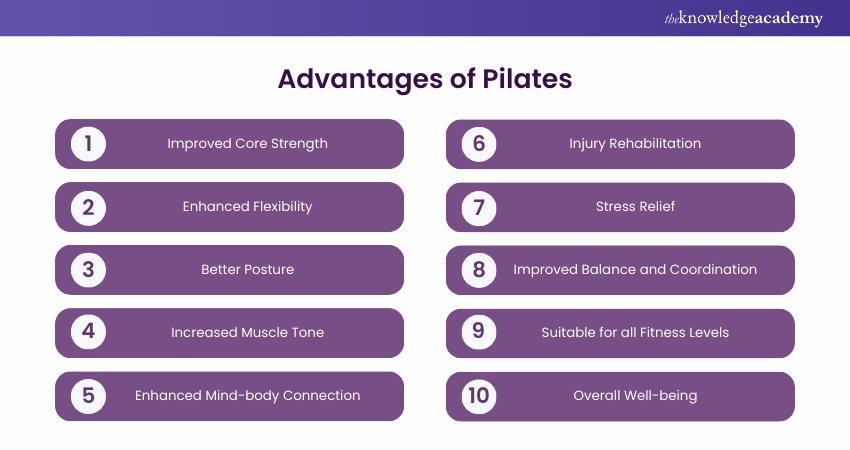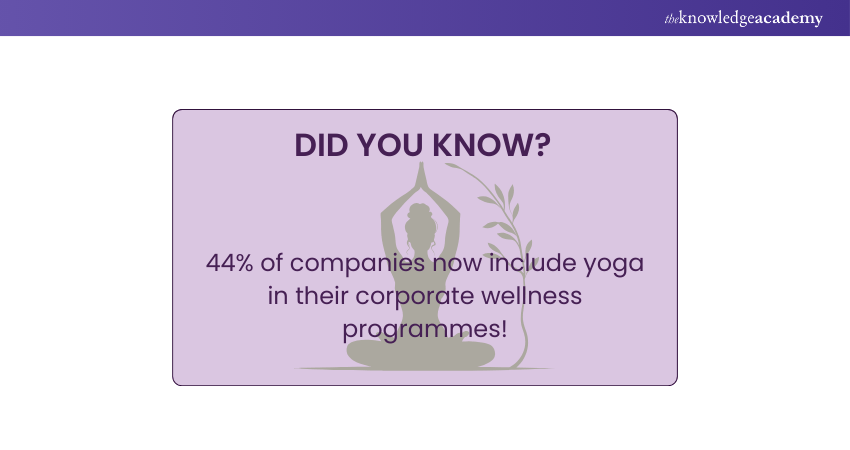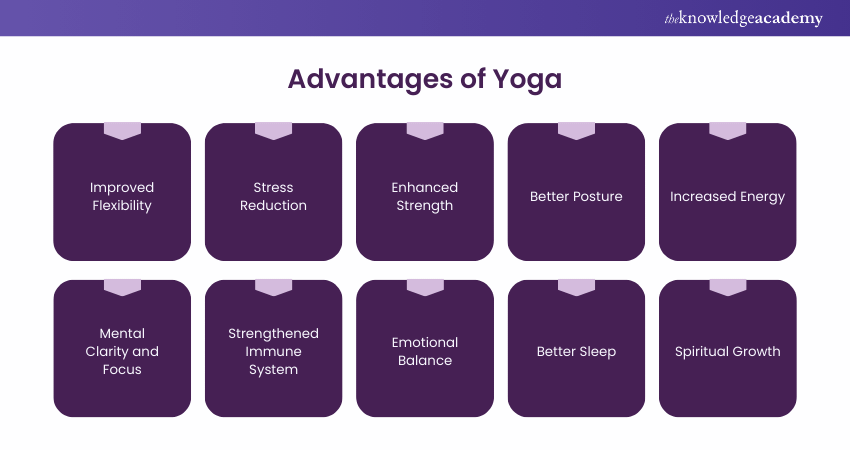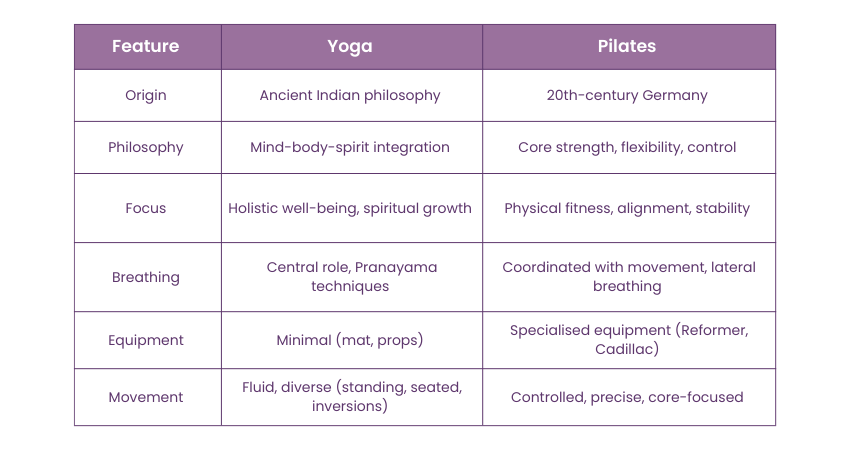We may not have the course you’re looking for. If you enquire or give us a call on 01344203999 and speak to our training experts, we may still be able to help with your training requirements.
We ensure quality, budget-alignment, and timely delivery by our expert instructors.

Are you caught at the crossroads of fitness and mindfulness, pondering the age-old question: Pilates vs Yoga? These two practices stand as pillars of strength and serenity in the world of wellness, both providing a distinct path to physical and mental well-being.
Pilates attracts individuals looking for a dynamic fitness routine by emphasising core strength and precise movements. Meanwhile, Yoga, deeply rooted in ancient tradition and philosophy, invites practitioners to explore a path of self-discovery and spiritual enlightenment.
For countless fitness enthusiasts, choosing between these two can be a perplexing dilemma. If you find yourself among those torn between the two forms of exercise, fret not; we're here to simply use these techniques for you. By the end of this blog, you'll clearly understand the difference between Pilates vs Yoga.
Table of Content
1) What is Pilates?
2) Advantages of Pilates
3) Types of Pilates
4) What is Yoga?
5) Advantages of Yoga
6) Types of Yoga
7) Pilates vs Yoga: What’s the Difference?
8) Yoga vs Pilates: Which One to Pick?
9) Is Pilates or Yoga Better for Belly Fat?
10) Is It Better to Do Yoga or Pilates First?
11) Conclusion
What is Pilates?
Pilates originally known as “Contrology” focuses on improving physical strength, flexibility, posture, and mental awareness through a series of controlled movements.The regimen emphasises proper posture, controlled breathing, and harmonious mind and body integration.
Pilates is designed to elevate flexibility, muscle strength, endurance, and posture, contributing to both physical as well as mental health. Whether utilising specialised apparatus or a simple mat, Pilates offers a dynamic fitness method that caters to people across all age groups and abilities.
Advantages of Pilates
Pilates offers numerous advantages which extend beyond mere physical fitness. Here are the listed benefits:

1) Improved Core Strength: Pilates focuses on core strengthening by targeting deep Abdominal, Pelvic floor, and back muscles for improved stability and strength.
2) Enhanced Flexibility: Regular Pilates exercise practice helps enhance muscles and joint flexibility to improve the overall motion range.
3) Increased Muscle Tone: By engaging various muscle groups in a balanced and controlled manner, Pilates helps in body sculpting and toning. This leads to a more defined physique.
4) Enhanced Mind-body Connection: Pilates prioritise mindfulness and concentration while nurturing a profound mind-and-body connection.
5) Injury Rehabilitation: Pilates exercises are highly adaptable, making them ideal for injury-recovering individuals. They can be tailored to rehabilitation aid and strengthening of specific areas affected by injury.
6) Stress Relief: Pilates focuses on controlled breathing and fluid movements for enhanced relaxation and reduced stress levels.
7) Suitable for all Fitness Levels: It offers adaptable exercises suitable for individuals of any age with all fitness levels for diverse audience accessibility.
Your journey to wellness begins here- Sign up for our Active and Healthy Lifestyles Training today!
Types of Pilates
Pilates encompasses various styles, each delivering unique benefits while consistently upholding its fundamental principles of control, precision, flow, concentration, centring, and breathing. Here are some popular types of Pilates listed:
1) Classical Pilates: Classical Pilates follows the original sequence designed by Joseph Pilates, combining both mat and equipment exercises. It focuses on structured movement flows that give your body a complete range of motion. This type is ideal for those who want to experience the classic and timeless form of Pilates.
2) Contemporary Pilates: Contemporary Pilates adds a modern twist to the classical approach. It basically mixes traditional exercises (such as Classic Pilates) with new techniques, incorporating bodyweight moves, external resistance, choreography, and even other fitness style elements.
3) Reformer Pilates: Reformer Pilates uses a specialised machine called a Reformer. This includes a sliding Carriage and adjustable Springs for resistance. It allows for a broader exercise range for strength, flexibility, and control targeting. This Pilates type is great for people looking for a more intense workout that can be customised to their fitness level.
4) Mat-based Pilates: Mat-based Pilates is the most accessible and beginner-friendly. It requires only a mat and focuses on fundamental movements. It’s an affordable way to get started with Pilates while learning the fundamentals of this versatile exercise system.
What is Yoga?
Yoga, an ancient practice from India, offers a comprehensive path to wellness in comparison to Pilates. It blends physical poses (Asanas), breath control (Pranayama), Meditation, and ethical principles.

Yoga transcends mere physical activity, directing practitioners on a profound spiritual journey for body, mind, and soul unification. Through its practice, individuals cultivate self-awareness, promoting self-realisation and achieving a heightened consciousness state.
Yoga's varied styles, ranging from the dynamic flows of Ashtanga and Vinyasa to the calming stillness of Hatha and Yin, all share a common goal. They harmonise with the supreme essence, fostering inner tranquillity and leading to spiritual awakening.
Advantages of Yoga
The Benefits of Yoga are wide and extend beyond physical fitness. Here are some of those key benefits:

1) Enhanced Strength: Many yoga postures require the engagement of various muscle groups, which helps in strength and stamina-building. This is particularly beneficial for areas like the core, arms, legs, and back.
2) Better Posture: Through Yoga practises, individuals develop awareness of their body alignment, leading to improved posture and spinal health.
3) Increased Energy: Continuous Yoga practice can boost energy levels through body circulation stimulation. It also helps alleviate feelings of fatigue by promoting better oxygen flow throughout the body.
4) Mental Clarity and Focus: It fosters mindfulness and concentration, soothing the mind and enhancing cognitive abilities. This practice also sharpens focus and improves mental clarity.
5) Strengthened Immune System: Stress-reducing Yoga benefits and its deep breathing emphasis can support a healthy immune system. This can help alleviate the risks of illness and enhance overall resilience.
6) Emotional Balance: This practice provides a safe space for emotional release and introspection, fostering a sense of balance, resilience, and emotional well-being.
7) Better Sleep: Practicing Yoga before bedtime can promote relaxation and relieve tension, leading to deeper, more restful sleep.
8) Spiritual Growth: For those seeking spiritual fulfilment, Yoga offers a pathway to self-discovery, inner peace, and connection to something greater than oneself.
Types of Yoga
Yoga comes in many forms, offering something for everyone, whether you're a beginner, looking for a workout, or seeking relaxation. Here are some popular Yoga types described below:
1) Vinyasa Yoga: Vinyasa Yoga features fluid, breathing-synchronised dance-like movements. This dynamic Yoga form involves holding poses for brief periods, making it excellent for your heart rate improvement and enhancing overall fitness.
2) Hatha Yoga: Hatha Yoga is slower and gentler, with shorter poses, lasting for a few breaths. This type is beginner-friendly for those who are aiming for a calmer experience. To understand the difference between Hatha Yoga and Vinyasa, it helps to recognize that Vinyasa typically includes continuous movement between poses, which creates a more vigorous flow compared to Hatha's focused, slower transitions.
3) Yin Yoga: Yin Yoga focuses on long-held, seated poses for deep connective tissue stretch. This approach is perfect for mobility and rehabilitation improvement and also offers a meditative Yogic approach.
4) Ashtanga Yoga: Ashtanga Yoga presents a specific pose sequence performed in a fixed order, advancing only as you master each level. This structured practice enhances strength, flexibility, and endurance.
5) Iyengar Yoga: Iyengar Yoga emphasises precision and alignment, often using props like straps or blocks. It’s especially beneficial for people with injuries. However, it should be practised with a doctor’s approval.
6) Restorative Yoga: Restorative Yoga helps in muscle tension release along with slow movements and supportive props like Bolsters and Blankets—ideal for relaxation and stress relief.
7) Kundalini Yoga: Kundalini Yoga combines repetitive movements with breathing, chanting, and meditation. This type aims to boost self-awareness and mental clarity, offering a more spiritual approach to yoga.
8) Bikram Yoga and Hot Yoga: These Yoga styles are practiced in heated rooms, but they have distinct differences. Bikram Yoga follows a fixed set sequence of poses in a heated room with temperatures over 100 degrees Fahrenheit. In contrast, Hot Yoga offers more flexibility in its movements and sequences.
Pilates vs Yoga: What’s the Difference?
Pilates and Yoga differ in their approaches to wellness and self-discovery. While both techniques offer numerous benefits for physical and mental well-being, they differ in several key aspects. The following are the key differences between Yoga vs Pilates:

1) Origin and Philosophy
Yoga emphasises the integration of the mind, body, and spirit through the amalgamation of physical postures (Asanas), breathwork (Pranayama), and meditation. Its primary goal is to promote holistic well-being and spiritual growth.
In contrast, Pilates focuses on core strength build-up, flexibility improvement, and enhancing muscular balance and control. It emphasises alignment, stability, and controlled movement patterns to promote overall fitness.
2) Focus
Yoga emphasises the integration of mind, body, and spirit through a combination of physical postures, including Asanas, Pranayama, and Meditation. On the other hand, Pilates focuses on building core strength, boosting flexibility, and enhancing muscular balance and control. It emphasises alignment, stability, and controlled movement patterns to promote overall fitness.
3) Breathing
Breath awareness and control are fundamental Yogic aspects. Pranayama, a type of breathing Yoga, are employed to elevate concentration, facilitate movement, and promote relaxation.
In contrast, while breathing is also incorporated into Pilates, it does not hold the same central role as it does in Yoga. Pilates typically emphasises lateral breathing, where the breath is coordinated with movement to enhance core engagement and stability.
4) Equipment
Yoga generally requires minimal equipment, with practitioners often using just a mat for practice. However, props such as blocks, straps, and bolsters may be used to support and deepen certain postures.
In contrast, Pilates can be performed on specialised equipment such as Reformer, Cadillac, or chair, which utilises springs and pulleys to provide resistance and support during exercises.
5) Movement Patterns
Yoga encompasses a broad spectrum of movement patterns. These include standing, seated, supine, and prone poses, as well as poses for inversions and balancing.
In contrast, Pilates focuses on controlled, precise movements targeting specific muscle groups. Exercises can be performed in numerous positions, such as lying down, sitting, kneeling, or standing, with an emphasis on core stabilisation and proper alignment.
Discover the art of healthy living with our Nutrition and Fitness Training – Join this trending course today!
Yoga vs Pilates: Which One to Pick?
Both Yoga and Pilates offer a distinct level of benefits, and choosing the correct one depends on your individual needs and preferences.
Yoga:
a) Flexibility, Balance, and Mindfulness: Yoga prioritises these core aspects for improved overall well-being.
b) Versatile Practice: Yoga can easily adapt to various goals and abilities with different styles. These include Restorative Yoga, Acro Yoga, and Chair Yoga.
c) Instructor Guidance: Yoga is crucial for adapting poses to individual abilities, ensuring safety by considering health conditions, and customising the optimal effectiveness practice.
Pilates:
a) Low-Impact Exercise: Suitable for older adults and those recovering from injuries, offering a gentle yet effective workout.
b) Mat vs. Equipment-Based Pilates: Mat Pilates is equipment-free, while equipment-based Pilates uses tools like reformers to add resistance.
c) Proper Instruction: Essential to prevent injuries and ensure correct technique.
If your goal is to elevate balance, flexibility, and mindfulness, Yoga might be the better choice, especially with its adaptable fitness style-centric Yoga types like Restorative or Chair Yoga.
However, if you want to focus more on core strength and stability with a low-impact workout, Pilates would be ideal, particularly for older adults or those recovering from injuries.
Is Pilates or Yoga Better for Belly Fat?
Pilates is generally more effective than yoga for targeting belly fat. It focuses on strengthening core muscles and often uses equipment like resistance bands or reformer machines to add intensity, increasing calorie burn and promoting fat loss.
Over time, Pilates can help improve posture and sculpt lean muscle, making it a better choice for belly fat reduction. However, Yoga also has its benefits, such as improving flexibility, relieving stress, and enhancing mindfulness.
Is It Better to Do Yoga or Pilates First?
Yoga is often better for beginners because it is more accessible and helps build a foundation for flexibility, breath control, and body awareness. Yoga allows you to ease into movement and develop flexibility, breath control, and body awareness. This makes it a great first step before transitioning to Pilates, which typically requires more precise techniques and core strength.
However, if you choose to start with Pilates, it is recommended to begin with mat-based exercises to learn the basics before progressing to equipment such as reformer machines.
Register now for our Meditation Course for a happier tomorrow!
Conclusion
Choosing between Pilates vs Yoga depends on your individual goals and needs. Pilates emphasises core strength and controlled movements, making it perfect for those seeking stability and muscle tone. On the other hand, Yoga focuses on flexibility, mindfulness, and spiritual connection, making it ideal for those pursuing a holistic approach to wellness. Both practices offer significant benefits, so the best choice is the one that aligns with your fitness aspirations and lifestyle.
Become the catalyst for growth with our Life Coach Training – Kickstart your transformational coaching journey today!
Frequently Asked Questions
Is Pilates as Relaxing as Yoga?

Pilates, while focusing on core strength and alignment, can be as relaxing as Yoga. It promotes mindfulness and controlled breathing, similar to yoga, which helps reduce stress and enhance relaxation.
What is Harder Yoga or Pilates?

Pilates is often considered more complex than Yoga because it requires precise movements and focuses heavily on core strength and muscle engagement. In contrast, despite being challenging, Yoga is more about flexibility, balance, and mindfulness, which is comparatively easier to perform physically.
What are the Other Resources and Offers Provided by The Knowledge Academy?

The Knowledge Academy takes global learning to new heights, offering over 3,000 online courses across 490+ locations in 190+ countries. This expansive reach ensures accessibility and convenience for learners worldwide.
Alongside our diverse Online Course Catalogue, encompassing 19 major categories, we go the extra mile by providing a plethora of free educational Online Resources like News updates, Blogs, videos, webinars, and interview questions. Tailoring learning experiences further, professionals can maximise value with customisable Course Bundles of TKA.
What is Knowledge Pass, and how Does it Work?

The Knowledge Academy’s Knowledge Pass, a prepaid voucher, adds another layer of flexibility, allowing course bookings over a 12-month period. Join us on a journey where education knows no bounds.
What are Related Healthy Lifestyles Courses and Blogs Provided by The Knowledge Academy?

The Knowledge Academy offers various Healthy Lifestyles Courses, including Yoga courses, Active and Healthy Lifestyles Training, and Meditation Course. These courses cater to different skill levels, providing comprehensive insights into What is Meditation?.
Our Health and Safety Blogs cover a range of topics related to Yoga, offering valuable resources, best practices, and industry insights. Whether you are a beginner or looking to advance your Health & Safety knowledge, The Knowledge Academy's diverse courses and informative blogs have you covered.
Upcoming Health & Safety Resources Batches & Dates
Date
 Life Coach Training
Life Coach Training
Fri 11th Apr 2025
Fri 13th Jun 2025
Fri 15th Aug 2025
Fri 10th Oct 2025
Fri 12th Dec 2025






 Top Rated Course
Top Rated Course



 If you wish to make any changes to your course, please
If you wish to make any changes to your course, please


